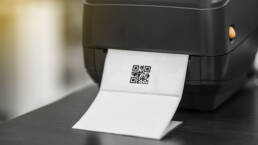Introduction
A shipping label printer is a device that prints the barcode and order information on shipping labels. Shipping printers are a vital piece of shipping equipment because they enable you to customize your packaging and improve business efficiency. A shipping label printer usually offers both thermal printing as well as ink-jet printing. Label printers can deliver very high quality printouts, with excellent resolution and clarity.
What is a shipping label printer, and why do you need it?
A shipping label printer is a device that prints the barcode and order information on shipping labels. These labels are placed on packages, pallets, and crates to help automate the shipping process. They can be used with any type of package or container.
Label printers typically have several features including:
- Barcode printing capabilities
- Data entry methods such as keyboard input or via touch screen display
- Able to print multiple lines of data (such as address information) at once
Shipping label printers are a vital piece of equipment for businesses that ship large volumes of packages. They enable you to customize your packaging, improve business efficiency and reduce costs by creating customized shipping labels. Using label printers, you can easily print barcodes and other information directly onto the shipping container.
Customized labels also make it easier for your customers to identify their packages at their destination. If a package is lost or damaged in transit, it will be easy for them to contact the sender with details about what was inside the package. Labels are available in many different sizes and shapes so that they fit any size box you might use.
A shipping label printer usually offers both thermal printing as well as ink-jet printing.
If you need to print labels with your own printer, consider a thermal label printer. Thermal printers are faster and more durable than ink-jet printers and can be used for a variety of industries.
The main difference between thermal and ink-jet printing is that thermal printers use heat to transfer the image onto the label stock or media. It’s not quite as simple as just melting an image onto the paper though; instead, there are sensors that detect where on the surface of the label stock there is no ink applied yet (because it hasn’t been printed yet) and then apply heat to melt those areas so that when they cool down again they will adhere to their permanent position on top of whatever information was already printed on top of them.
Inkjet technology takes longer because it has more steps involved: first you print something using an ink cartridge onto some kind of paper which then needs time before being able to have another layer put over top without causing smudging problems (which means even more waiting time). What’s worse is if you want something really intricate like logos or pictures with lots of detail – these things take forever!
Label printers can deliver very high quality printouts, with excellent resolution and clarity. Resolution is the number of pixels per inch (dpi). DPI stands for dots per inch, which refers to the quality of your printed image. The higher the DPI setting, the better your printout will look. Inkjet label printers are generally more expensive than thermal or laser label printers because they use ink instead of toner or heat to create their output.
A shipping label printer offers business owners the ability to create custom printed forms, tags, and labels in-house.
You may have the best products in your industry, but you still need to have a place to sell them. A shipping label printer offers business owners the ability to create custom printed forms, tags, and labels in-house. These printers are also helpful for identifying products that are being sold on consignment or used as part of an inventory system.
Here are some things to keep in mind when choosing a label printer:
- The number of labels you print each day will determine how much you spend on ink cartridges over time. It’s important to choose a label maker with an efficient printing method that doesn’t waste too much ink per label printed.
- You’ll want to look at whether or not your desired machine has been designed specifically for use in certain types of environments; this might include warehouses, offices or retail stores with large amounts of foot traffic passing by frequently every day (or even hourly). If so then make sure that this particular model has been tested thoroughly before making any commitments!

Conclusion
The shipping label printer is a vital piece of equipment for any business. Not only can it save time and money by eliminating the need to order custom forms from outside sources, but it also makes it possible to customize your packaging in any way that you want. The ability to create printed labels right at home reduces waste and saves money while helping ensure privacy when needed.
Related Posts
17th December 2022
5 Reasons Group Exercise is a Must-Have in Your Business
The benefits of group exercise extend far beyond personal health. Group fitness…
25th October 2022
The Basic Difference Between MFA and 2FA – Which is Better?
In the past, businesses relied on single authentication to confirm who was…
24th October 2022
Why Do We Need Virtualization – Top 5 Benefits
Before now, using a single machine for a single application was common across…







